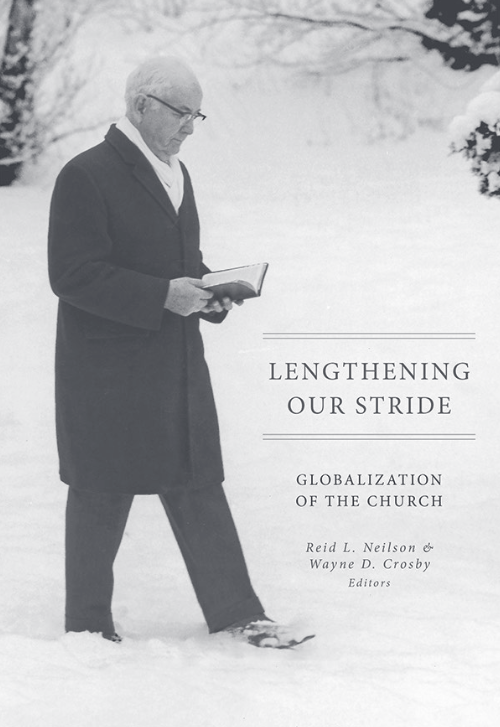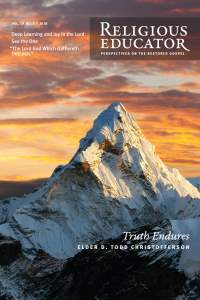Review of "Lengthening Our Stride: Globalization of the Church"
D. Brent Smith
D. Brent Smith, "Review of Lengthening Our Stride: Globalization of the Church," Religious Educator 19, no. 3 (2018): 159–61.
D. Brent Smith (brentsmith727@gmail.com) is a retired director of International Affairs for NOAA’s Satellite Service. He and his wife, Enid, were serving as North America Northeast Area Church History Advisers when this was written.
Reid L. Nielson and Wayne D. Crosby, eds. Lengthening Out Stride: Globalization of the Church. Provo UT: Religious Studies Center; Salt Lake City: Deseret Book, 2018. $27.99, 367 pages.

Lengthening Our Stride: Globalization of the Church, published in January 2018 by the BYU Religious Studies Center and Deseret Book, builds upon the landmark 4 April 1974 address of President Spencer W. Kimball to LDS regional representatives in which he, in the initial months of his presidency, called upon the Church and its leaders to “lengthen our stride” and “enlarge our vision” in taking the gospel to “all nations.” Edited by Reid L. Neilson, assistant Church historian, and Wayne D. Crosby, director of Global Support and Acquisitions in the Church History Department, the book includes twenty-one addresses presented in connection with annual conferences of the LDS International Society from 2006 to 2015, a BYU-based organization founded in 1989 that now has almost three thousand members, of which approximately 70 percent are Americans who have been engaged as expatriates in corporate and professional activities in the world abroad. (A collection of twenty previous International Society addresses presented at annual conferences from 1998 to 2005, Global Mormonism in the 21st Century, was edited by Reid Neilson and published in 2008 by the BYU Religious Studies Center.)
The visionary determination of Spencer W. Kimball mirrors the bold pronouncements of Mormonism’s founding prophet, Joseph Smith, who famously declared that “the truth of God will go forth boldly, nobly and independent, till it has penetrated every continent, visited every clime, swept every country, and sounded in every ear.”[1] In the four-plus decades following President Kimball’s address, his vision of global growth is in the process of being realized with more than fourfold increases in LDS membership, missions, numbers of missionaries, and stake/
Three of the volume’s twenty-one addresses were presented by non-American Church leaders. In his address “Caring for the Poor and Needy” in April 2014, Elder Gérald Caussé (now Presiding Bishop of the Church) noted that the majority of Church growth is in poor and developing nations—with some 45 percent of Church members then living in developing countries. Elder Adesina J. Olukanni, a native of Nigeria who was then an Area Authority Seventy, focused in his 2010 address on ethical challenges facing the international Church, particularly in Africa. Michael Otterson, a UK native who was then managing director of Church Public Affairs, addressed in 2012 the Church’s increasing global visibility, as a counterpart to the “Mormon moment” being experienced in the United States. Other presentations include Professor Valerie Hudson addressing the effect of demographic and gender-related trends on nations, regions, and the international system; separate addresses on humanitarian-related efforts by Sharon Eubank (then director of LDS Charities) and BYU Professor Warner Woodruff; separate addresses on the religious freedom and religious liberty topic by University of Utah President Michael Young and BYU Law School professor Cole Durham; and a treatment of the intersection of the Church and international diplomacy by Elder Robert S. Wood, who has career expertise in international relations.
Often sensitive cross-cultural challenges relating to Church globalization are addressed in separate addresses by Elder Cree-L Kofford and Elder Dennis B. Neuenschwander, emeritus members of the First Quorum of the Seventy. Elder Kofford, in focusing on his experiences in Asia, notes that “what you see working well along the Wasatch Front does not always work well . . . in other parts of the world. . . . It is our responsibility to provide the kind of leadership that will bring people along as rapidly as they can come but no more rapidly than that, with compassion, understanding, and love” (291–92). Elder Neuenschwander, recalling his experiences in Eastern Europe, states that “the only way to put a local face to the Church is to use local faces. . . . The Church is best established when local leaders and members carry their share of the responsibility. We may know the Church culture, policies, and procedures better than they, but they know the intricacies of their own culture into which the Church must fit” (327).
I heartily recommend Lengthening Our Stride: Globalization of the Church as a valuable collection of addresses that illuminates both the opportunities and the challenges of an increasingly global LDS Church.
Notes
[1] Joseph Smith, “Church History” [Wentworth Letter], Times and Seasons, (1 March 1842,): 710.
